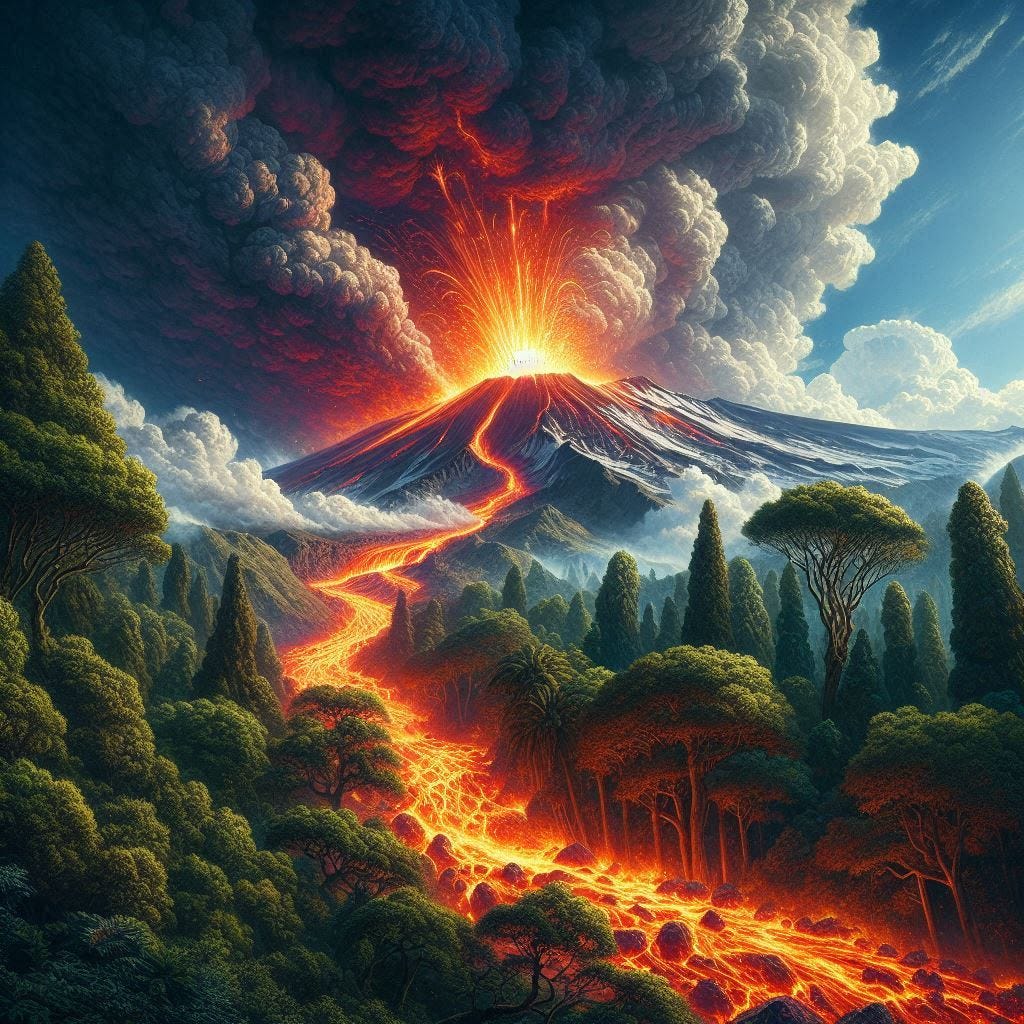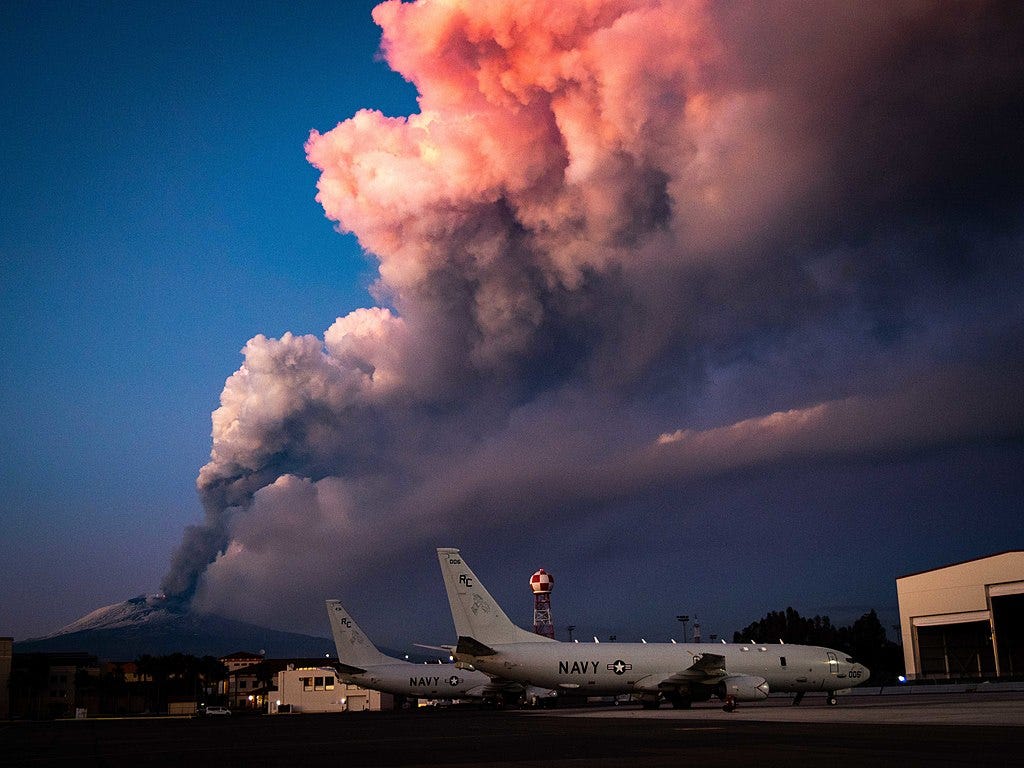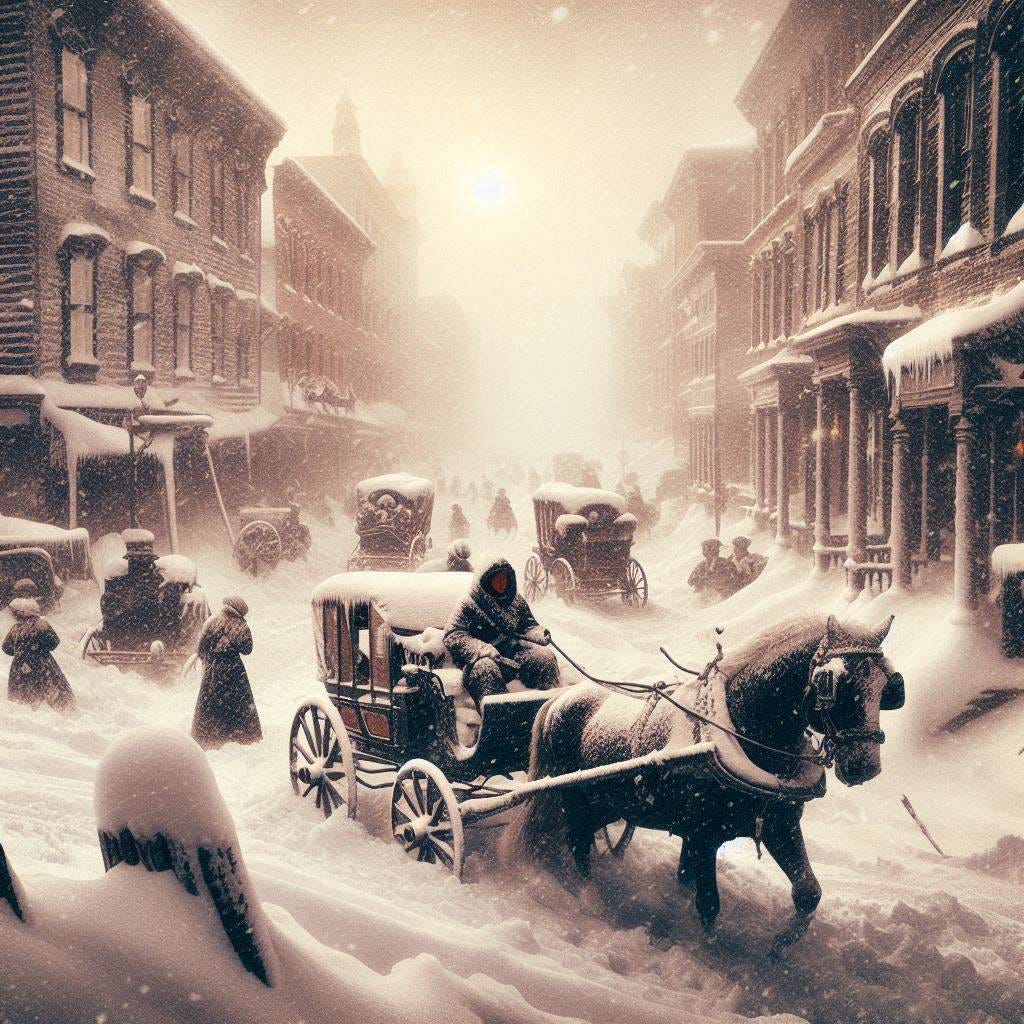The Mysteries of History (March 11 Edition)
Mount Etna Erupts; Great Blizzard of '88; Fukushima Disaster
1669 — Mount Etna Erupts
image generated using Bing Image Creator
Mount Etna dominates over Sicily; it can be seen from practically everywhere on that large island which makes up southwestern Italy. A series of volcanic eruptions that would ultimately claim more than 20,000 lives in Sicily began on this date in 1669.
Etna had been periodically erupting for hundreds of years; it is the most active volcano in Europe. Most of the victims during this series of eruptions could have survived had they evacuated; there was plenty of warning that disaster was likely imminent. In fact, the spewing of noxious gas, which began on this date in 1669, killed around 3,000 people living on the fertile slopes of the mountain.
Ash and lava followed, and was expelled with such violence that some of the ash fell on mainland Italy as much as nearly a hundred miles away. When lava began pouring down the side of the mountain, a team of men from Catania, a town in the path of the lava, attempted to divert the flow in a different direction, but were driven away by residents of another village that would have received the diverted lava had the first group been successful in their engineering attempts.
Still the people in Catania had time to flee, but most didn’t; they held out hope the lava would stop or the defensive walls built around the city would stop the molten rock but, of course, the lava flow didn’t cease, and the walls were no match for the literally red-hot lava. Seventeen thousand perished in that town alone.
One result of this catastrophe was that it became illegal in Italy to interfere with the natural flow of lava.
Etna continues to be active; in fact, more than half of its recorded eruptions have occurred within the last 125 years, including every year from 2001 through 2009 and again in 2012, 2018, 2021, and 2024.
2021 image of Mount Etna erupting from wikimedia commons
Questions: Would you feel safe being near Mount Etna? What would you do if it began rumbling or spewing ash and you were in the area? Is it common for people in dangerous areas to downplay the risk and remain (not just in the case of volcanic eruptions, but also fires, tsunamis, and even such things as domestic violence)? Why do some people risk their lives where there are clear indications their life is in danger? Why may they not be able to leave even if they wanted to? What can be done to help them?
1888 — Devastating Blizzard Kills Hundreds and Changes Infrastructure
image generated using Bing Image Creator
On this date in 1888, one of the worst blizzards in U.S. history devastated the northeastern United States, a region where one-fourth of Americans resided at the time. It was called “The Great Blizzard of 1888” and also “The White Hurricane.” More than 400 deaths were attributed to the storm, which featured hurricane-strength winds and over four feet of snowfall in New York City.
The day before had been pleasant, in the mid-50s. But the weather took a dramatic turn for the worse the next day.
As a result of the death, destruction, and disruption caused by the storm, in the aftermath New York City began changing its infrastructure by moving things like its water and gas lines as well as trains (now called the subway system) underground.
Mark Twain was stuck in New York City at the time of the blizzard and had this to write about it, in a letter to his wife “Livy” (Olivia) at home in Connecticut:
And so, after all my labor and persuasion to get you to at last promise to take a week's holiday and go off with me on a lark, this is what Providence has gone and done about it. It does seem to me the oddest thing--the way Providence manages. A mere simple request to you to stay at home would have been entirely sufficient; but no, that is not big enough, picturesque enough--a blizzard's the idea; pour down all the snow in stock, turn loose all the winds, bring a whole continent to a stand-still: that is Providence's idea of the correct way to trump a person's trick. If I had known it was going to make all this trouble and cost all these millions, I never would have said anything about your going.
This was not the only historic blizzard of 1888; an earlier one, which struck the Plains Region of the U.S., was reported on here.
Questions: What other big storms have struck the Northeast since 1888? What is the worst storm or weather event you have ever experienced? Which do you think was worse: the Blizzard written of above or the earlier one in 1888 linked to above?
2011 — Fukushima Earthquake, Tsunami, and Nuclear Disaster
public domain image from wikimedia commons
On this date in 2011, a 9.0 earthquake off the coast of Japan caused a Tsunami that struck land within an hour. The death toll from those related events was approximately 18,000. The ensuing power outage and damage to backup systems caused by the Tsunami caused meltdowns at the Fukushima Daiichi nuclear plant, the (so far) second-worst nuclear accident after Chernobyl, which took place a quarter of a century earlier, in the Spring of 1986. Both accidents scored a “perfect” seven on the nuclear danger scale.
Only one death is considered to be directly attributed to the meltdowns at the nuclear plant, but 51 additional deaths are attributed to the evacuations that were ordered (some people having to evacuate multiple times, first evacuating to an area which is subsequently also evacuated). However, there’s no telling how many more may have died from radiation exposure had they not been evacuated from the area surrounding the nuclear plant, so claiming that the evacuations were unnecessary or even harmful is not a cut-and-dried proposition; it’s not an open and shut case by any means.
Questions: Have you seen the Japanese Docudrama The Days? Would you welcome a nuclear plant in your area if it would cause the cost of electricity to be significantly reduced? Would you welcome a nuclear plant in your area if it would mean employment for you or someone close to you?










